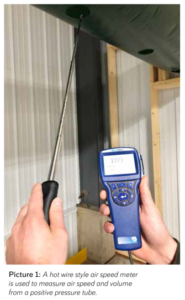Dr. Ryan Leiterman Contributes to Progressive Dairy Magazine
Dr. Ryan Leiterman’s recent article “Drafts: A Calf’s Best Friend or Greatest Foe” has been published in the Progressive Dairy Magazine.  This article addresses why drafts are traditionally thought of as a negative experience for calves and how they can be used to one’s advantage in certain situations. Read more here to learn what the pros and cons of drafts can be in calf barn ventilation.
This article addresses why drafts are traditionally thought of as a negative experience for calves and how they can be used to one’s advantage in certain situations. Read more here to learn what the pros and cons of drafts can be in calf barn ventilation.
Click here to view as a pdf: A calf’s best friend or greatest foe
By Dr. Ryan Leiterman
Drafts and pre-weaned calves – rarely is a topic so misunderstood. Many calf raisers are uncomfortable with the topic of drafts on calves, regardless of the outside temperature. Most people believe drafts are to be avoided at all costs. I once heard of a veterinarian who would spark a lighter in a calf pen and if the flame flickered, even the slightest bit, would declare the presence of a dangerous draft. Contrary to popular belief, however, drafts on pre-weaned calves are not always a bad thing. In fact, in certain situations, they can even be beneficial.
Drafts defined
What defines a draft? If you can feel air movement on your face, does that make it a draft on the calf? Is a draft always bad for calf health? These are simple questions, but the answers can be more complex.
Webster’s dictionary defines a draft simply as “a current of air …”. This definition implies it is neither good nor bad.
A paper published in 1986 by the American Society of Agricultural and Biological Engineers titled “Design of ventilation systems for poultry and livestock shelters” defined a draft as “airspeeds in excess of 29.5 to 59 feet per minute.” A definition with this level of precision makes nice lecture material for freshman veterinary students but leaves calf raisers looking for something more tangible. Most ventilation professionals today have universally accepted 60 feet per minute as a draft threshold for pre-weaned calves during times of cold weather.
Today, ventilation professionals have sensitive air speed meters that can be used to measure air speeds and volumes. The two most common air speed meters are the hot wire style (Picture 1) and the windmill style (Picture 2).
By knowing the airspeed at the calf level associated with different ventilation system settings, the calf manager can provide fast cooling airflow when calves are under heat stress or draft-free fresh air when calves are experiencing cold stress.
Drafts and thermoregulation
Heat loss happens through three processes:
1. Conduction
2. Convection
3. Radiation
A draft is a current of moving air that can increase heat removal rates through the convective process. If you burn your finger on a stove, you will probably blow on it. Why? Because we inherently know that by increasing airspeeds over a surface, we can cool the object faster. Moving air has the ability to strip heat off objects. This is the key to understanding drafts as they relate to calves – and all livestock, for that matter.
In the case of cold weather, drafts are to be avoided because they will exacerbate cold stress. But in the case of hot weather, the convective properties of drafts can help calves stay cool.
Young calves have a thermoneutral zone of 50ºF to 78ºF where they burn no additional calories to maintain body temperature. This means that when temperatures dip below 50ºF, calves begin to burn calories to stay warm and, above 78ºF, they burn calories in metabolic cooling processes.
Simply put, when it is above 78ºF, calves can benefit from a draft to assist in heat abatement. When it is below 50ºF, calves should not be exposed to airspeeds greater than 60 feet per minute in order to prevent excess convective heat loss. There is a gray area about how to ventilate for temperatures between 50ºF and 78ºF. Science has yet to pin down an ideal airspeed versus ambient temperature relationship. Until that day comes, calf raisers are left to use their experience to guide their decision-making process.
Additional benefits of properly managed drafts
During hot summer weather, drafts on calves can have benefits beyond heat abatement. Some calf raisers have reported a 50% reduction in bedding during summer months when using a high-speed (drafty) ventilation system because the fast air helps keep the bedding dry for longer periods of time.
Fly pressure can also be reduced with drafty ventilation systems in the summer. Flies do not like to be in a draft. Experience has shown if calves can reside in a stream of air moving roughly 176 feet per minute (2 miles per hour) or greater, flies will often avoid the calf to avoid the associated draft.
The idea of regulating airspeeds based on ambient temperature now leads to bigger questions. Does your calf barn ventilation system allow you to change the speed of air at the calf level along with changing ambient temperatures? Can it easily move back and forth between the fast cooling air and slow, draft-free air based on outside temperature, especially during times of seasonal transition like the spring and fall when days are hot and nights are cold?
In the future, before proclaiming all drafts are bad for young calves, remember: It is not the airspeed but rather the airspeed in relation to the ambient air temperature that determines if it will have a helpful or harmful effect on calf health. Ventilation systems that allow the calf raisers to adjust airspeed at the calf level based on temperature will help calves remain healthy in the face of changing weather conditions.
This article was originally published with the Progressive Dairy Magazine at https://www.progressivedairy.com/topics/calves-heifers/drafts-a-calf-s-best-friend-or-greatest-foe



